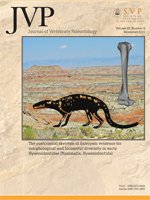Junya Watanabe, Hiroshige Matsuoka
Journal of Vertebrate Paleontology 35 (6), (1 November 2015) https://doi.org/10.1080/02724634.2014.994745
A flightless fossil duck (Aves, Anatidae), Shiriyanetta hasegawai, gen. et sp. nov., is described as a member of the Shiriya local fauna, a middle—late Pleistocene marine and terrestrial vertebrate fauna from fissure-fill deposits in the Shiriya area, northeast Japan. The species is represented by isolated bones, including skull fragments, vertebrae, pectoral and pelvic girdle elements, and most of the major limb elements. Osteological features of Shiriyanetta suggest that it had taxonomic affinity with tribe Mergini (seaducks) of subfamily Anatinae, and specifically with Recent Polysticta and Somateria (eiders). Although the overall large size, several unique skeletal features, and the proportions of the limb bones of Shiriyanetta strongly resemble North American seaducks of the genus Chendytes Miller, 1925, extinct relatives of Somateria, most elements of the two genera are diagnostically different from one another. Comparisons of these taxa and other flightless anatids with their relatives show that some of the apparently shared osteological features of Shiriyanetta and Chendytes are probably associated with flightlessness rather than reflecting a close relationship between the two genera. Given that Recent Somateria has an impaired flight ability, or the occurrence of a temporary flightless condition, it is quite possible that Shiriyanetta and Chendytes might have lost their flight ability independently, resulting in the contemporaneous occurrence of flightless ducks on both sides of the Pleistocene North Pacific.

